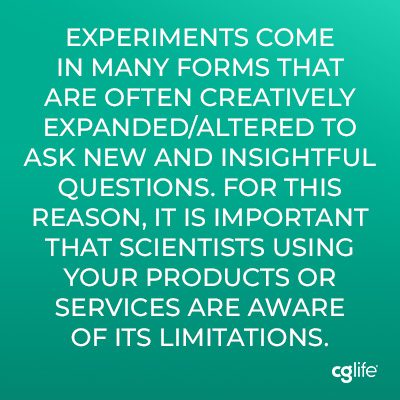

Purchasing Power: Reflections from a Laboratory Pocketbook Keeper
Biotech, pharma, and other scientific research operations increasingly have access to large sums of cash in the form of grants and/or R&D spending, as the economic and social impact of science continues to expand. With further growth in scientific operation market share, it becomes more and more important to understand how purchasing decisions are made within the lab by understanding the mindsets of those who make them.
Purchasing is not typically managed by the highest authority in a lab. The principal investigators and managers have too much on their plate to manage the “mundane” details like “do we have enough nitrile gloves, solvents, and antibodies?”
As one of the first members of my Ph.D. laboratory, this job fell to me, above and beyond my full-time research. I assumed the primary purchasing role for our group of 15 and had the final call on which products and services we chose. While this comes with the perk of knowing my own materials would be rapidly stocked, I was also responsible for making sure that all other lab members had what they needed. Any delays could bottleneck the entire research operation, so the job had to be done well.
As such, it is critically important to help make this process move smoothly for scientists, who primarily want to collect quality data. As a company, understanding this is powerful because once you have established the trust and connection with an individual, they will perpetually keep you in mind for their ongoing research needs – not least for the purpose of reproducibility. Once your product is adopted into lab protocol and published in a manuscript you become the “go-to” provider.
To help streamline this process, below are some best practices collected from my experience, along with some strongly-worded pitfalls to avoid.
Good/bad (and possibly ugly) practices for making nice with laboratory purchasers
Good: Understand how your key customers are finding and purchasing from you.
Remember that at the university level (where federal research funds are king), purchasing is often run through third-party applications to better track the spending and to allow savings on taxes, where possible. This means that sometimes all the hard work we put in on the marketing and content side isn’t even visible unless the researcher is eager enough to click on several pop-out windows (which, in my experience, can be quite faulty). Even if this is not your fault, it may keep sales at bay. If you have a good amount of university business or wish to expand it, it pays to check with individuals at a given university about how the shopping applications work. While they may not be able to give you access, gleaning any information on how products are displayed is valuable. Tailoring your product descriptions to better fit the university marketplace’s set-up/lay-out can help customers find your product and choose it over similar offerings.
Good: Provide honest assessments/ratings from scientists who have previously used the product.
In recent years, I have been happy to see a number of scientific services adopting Yelp-style customer reviews. While it may be intimidating to offer this service (unfiltered), experimentalists are usually not as fickle as the average Yelper. While you may fear horrific reviews, you can also expect honest, data-driven ones. If you have a good product, this will shine through. If your product or service is deficient in some way, you can use that direction information to refine it. If I saw even a few customer testimonials published in open feedback sections, I would be much more likely to try the product for my lab’s needs. Some may even include tips for how to best use your products or services, increasing customer satisfaction.
Good: Be honest about your product or service limitations.


If there are clear and known limitations of your product in certain experimental set-ups or applications, say so. Nothing sours a customer experience more than realizing you had wasted money, time, and energy on something doomed from the start, especially if they could have prevented it. Of course, you want to position your product in the best possible light, but ultimately the big money comes from repeat purchases and lasting relationships.
Experiments come in many forms that are often creatively expanded/altered to ask new and insightful questions. For this reason, it is important that scientists using your products or services are aware of its limitations. While this may mean turning away business in the short-term, one disastrous experiment can doom you forever.
Good: Proactively offer QC information.
I would jump for joy whenever a company provided resources that allowed me to rapidly and definitively QC their product (beyond the initial in-house quality control). To be clear, expiration dates often don’t cut it – you need to remove the burden of pre-experimental validation. A mid-sized experiment often requires a dozen different products, and their function requires validation in a controlled manner. Sometimes validation controls can be built into the experiment itself, but often much of the validation work must occur immediately prior to the main experiment, to minimize experimental clutter. Therefore, if you provide recent and relevant QC information, you can save them from a few preliminary experiments. That said, the ever-skeptical scientist may still desire to QC the product themselves (good on them). If you can provide meaningful procedures and/or conditional suggestions to test this product’s activity, you will save them from developing new protocols that only test product function and not their primary research question. Of course, this means that you have handed your consumer the ability to detect a faulty product, but generally scientists care more about knowing then determining blame. In turn, you may need to send additional materials their way, but at the end of the day, you’re supplying a quality product. By giving the consumer the power to know for themselves what to look for, you save them time… and rage.
Bad: Providing an excess of information, rather than curated and essential information.
Scientists love information. The process of collecting and originating it is a huge part of what makes them love their jobs, despite the, at times, enormous pressure to produce peer-reviewed papers. However, in the 21st century, there is so much information out there, even for really small research fields (A Brave New World got that right). As a result, reading and understanding information consumes a large chunk of their day. Their supervisors are eagerly (and often not patiently) waiting for experimentation and data collection. In fact, supervisors can get frustrated if they see their scientists spending too much time on papers/the computer and not at the bench — even if they need that information to perform the experiment in question. When researchers are searching for a product or information, they want to get to the heart of it quickly. You are the expert on your own product, so actively serve your customers the most critical information, instead of listing papers and procedures without context. Summaries and tables go a long way in this regard. If they need more information, the curated information you provide can guide them on how to find out more.
Bad: Company contacts can’t solve scientific problems.
When I was really stuck on a problem or when a product was not performing as advertised or expected, it was great to be able to speak to someone in customer support. However, I found it surprising that some companies don’t have product experts readily available to answer questions. While I understand that company scientists are busy doing science, there needs to be infrastructure for them to help make sure their product (their baby) is working for the people paying for it. Having a sales/administrator as the only point of contact leads to delays or even worse, misinformation. If possible, I recommend having sales and product services as separate contact points, even at small companies.
Bad: Sending sales teams around to labs at random and unprompted times in the day.
Imagine members of a laboratory busily reading over papers, pipetting solutions, or discussing data – a lab buzzing with important work. Now imagine a knock at the door by a person no one has ever before seen. Everything slows as the group looks to the stranger in logoed gear. “Who manages the purchasing for the group?” he asks as I sigh out loud.
As mentioned earlier, the role of purchaser is typically a secondary task. Like me, they may be performing their own research, and they are certainly not waiting with bated breath for “the best deals in town” to land on their bench. This interruption may seem minor, but it is a distraction from high-intensity, high-focus work. And the time adds up: There are a ton of companies out there, doing the exact same thing. On days where multiple reps stop by to pitch their value, I would find the closest pillow so I could scream/cry into it. Instead, reach out to lab contacts offering help to find better deals on stuff they need. You’re better off emailing or scheduling events to advertise what makes your company excel than plastering my desk with business cards, while I fail to execute my experiment.
Ugly: DO NOT GIVE THEM THE RUNAROUND.
Finally, I’ll share some of the ugly via an experience I had with an unnamed company.
To save time, my colleagues and I were directed by our supervisor to order reagents we could otherwise make ourselves from a specific well-established company (with 40 years of in-field experience), which he had ordered from a number of times previously in his career. Some of these products didn’t arrive by the expected delivery date. So, I called to inquire on the shipping status. The contact indicated they would know better in about a week and that they would reach out by then to let me know. A week passes with no sign. I call again, and they explain they had an issue acquiring a product they need to make our product. They explained they should have it soon and to expect it in about two weeks. Okay, great.
Two weeks passed without any contact or product. So, I called again, this time more frustrated as we were now eight weeks in. The same contact explained that the issue is persisting. I ask when I can expect it; they don’t know. At this point, I go ahead and look up the chemical they needed. I was able to buy it immediately and have it within a week. So, I ask, why can’t they get it. She says she doesn’t know because she is not lab personnel. I ask if I can speak to one. She replies by saying, “No, that’s not part of their job.”
Believe it or not, this persisted for a few more iterations before the product finally arrived. It drove me crazy because I could make the damn thing myself. As a little side note, the contact had a bad habit (possibly nervous tick) of laughing when I would frustratingly ask when we could reasonably expect the material. Clearly, they were covering up some other internal failing at the company by blaming the science. While this might work occasionally, the tactic falls completely on its face if the client understands the science (they often do). When I asked for clarification on the scientific issue, it was readily apparent that excuse was a red herring.
The take-home is that you can’t expect to fool scientific clients with bogus excuses for long. If there is an internal problem within your company that keeps you from providing the agreed service, be upfront about it. If anyone can emphasize with external factors delaying planned delivery dates, it’s scientists. However, you must give them the option to wait or make other plans. You may lose their business in the short term, but you won’t necessarily lose them forever. As a result of my frustration, I perpetually avoided this company and insisted on alternatives. I also made sure to tell everyone I knew about this experience to save them from this poor behavior.
The purchaser may be just one person, but their impact may be more profound than you think. Do the right thing and ALWAYS be professional with the time of others. Now, I need some chamomile tea to help relax and lower my blood pressure.


